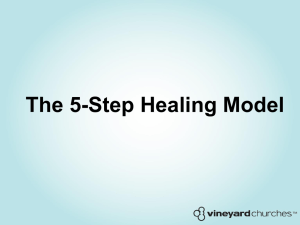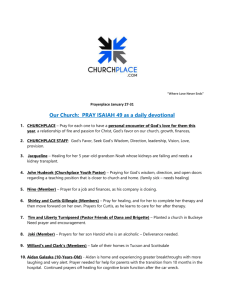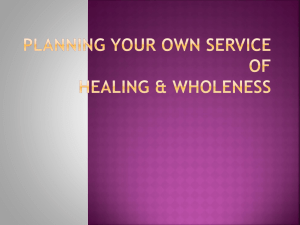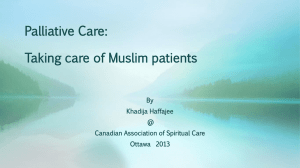Researchers Look at Prayer and Healing
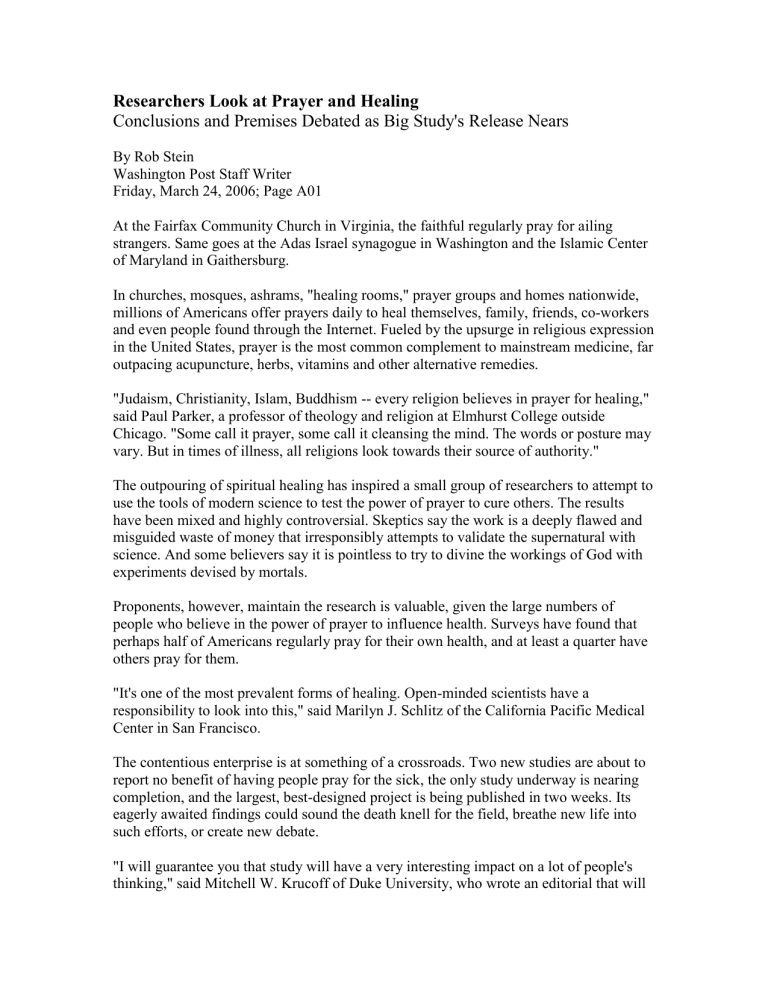
Researchers Look at Prayer and Healing
Conclusions and Premises Debated as Big Study's Release Nears
By Rob Stein
Washington Post Staff Writer
Friday, March 24, 2006; Page A01
At the Fairfax Community Church in Virginia, the faithful regularly pray for ailing strangers. Same goes at the Adas Israel synagogue in Washington and the Islamic Center of Maryland in Gaithersburg.
In churches, mosques, ashrams, "healing rooms," prayer groups and homes nationwide, millions of Americans offer prayers daily to heal themselves, family, friends, co-workers and even people found through the Internet. Fueled by the upsurge in religious expression in the United States, prayer is the most common complement to mainstream medicine, far outpacing acupuncture, herbs, vitamins and other alternative remedies.
"Judaism, Christianity, Islam, Buddhism -- every religion believes in prayer for healing," said Paul Parker, a professor of theology and religion at Elmhurst College outside
Chicago. "Some call it prayer, some call it cleansing the mind. The words or posture may vary. But in times of illness, all religions look towards their source of authority."
The outpouring of spiritual healing has inspired a small group of researchers to attempt to use the tools of modern science to test the power of prayer to cure others. The results have been mixed and highly controversial. Skeptics say the work is a deeply flawed and misguided waste of money that irresponsibly attempts to validate the supernatural with science. And some believers say it is pointless to try to divine the workings of God with experiments devised by mortals.
Proponents, however, maintain the research is valuable, given the large numbers of people who believe in the power of prayer to influence health. Surveys have found that perhaps half of Americans regularly pray for their own health, and at least a quarter have others pray for them.
"It's one of the most prevalent forms of healing. Open-minded scientists have a responsibility to look into this," said Marilyn J. Schlitz of the California Pacific Medical
Center in San Francisco.
The contentious enterprise is at something of a crossroads. Two new studies are about to report no benefit of having people pray for the sick, the only study underway is nearing completion, and the largest, best-designed project is being published in two weeks. Its eagerly awaited findings could sound the death knell for the field, breathe new life into such efforts, or create new debate.
"I will guarantee you that study will have a very interesting impact on a lot of people's thinking," said Mitchell W. Krucoff of Duke University, who wrote an editorial that will
accompany the closely guarded findings in the American Heart Journal. "But how you interpret the results will probably depend on your point of view."
Many studies done over the years indicate that the devout tend to be healthier. But the reasons remain far from clear. Healthy people may be more likely to join churches. The pious may lead more wholesome lifestyles. Churches, synagogues and mosques may help people take better care of themselves. The quiet meditation and incantations of praying, or the comfort of being prayed for, appears to lower blood pressure, reduce stress hormones, slow the heart rate and have other potentially beneficial effects.
But the most controversial research focuses on "intercessory" or "distant" prayer, which involves people trying to heal others through their intentions, thoughts or prayers, sometimes without the recipients knowing it. The federal government has spent $2.2 million in the past five years on studies of distant healing, which have also drawn support from private foundations.
San Francisco cardiologist Randolph Byrd, for example, conducted an experiment in which he asked born-again Christians to pray for 192 people hospitalized for heart problems, comparing them with 201 not targeted for prayer. No one knew which group they were in. He reported in 1988 that those who were prayed for needed fewer drugs and less help breathing.
William S. Harris of St. Luke's Hospital in Kansas City, Mo., and colleagues published similar results in 1999 from a study involving nearly 1,000 heart patients, about half of whom were prayed for without their knowledge.
But these and other studies have been called deeply flawed. They were, for example, analyzed in the most favorable way possible, looking at so many outcomes that the positive findings could easily have been the result of chance, critics say.
"It's called the sharpshooter's fallacy," said Richard Sloan, a behavioral researcher at
Columbia University. "The sharpshooter empties the gun into the side of a barn and then draws the bull's-eye. In science, you have to predict in advance what effect you may have."
Other studies have been even more contentious, such as a 2001 project involving fertility patients that became mired in accusations of fraud.
"I would like to see us stop wasting precious research dollars putting religious practices to the test of science," Sloan said. "It's a waste of money, and it trivializes the religious experience."
Even some advocates of incorporating more prayer and spirituality into medicine agree.
"I don't see how you could quantify prayer -- either the results of it or the substance of it," said the Rev. Raymond J. Lawrence of New York-Presbyterian Hospital/Columbia
University Medical Center. "God is beyond the reach of science. It's absurd to think you could use it to examine God's play."
Perhaps most important, many scientists say, is that there is no rational explanation for how this kind of prayer might work.
"There's nothing we know about the physical universe that could account for how the prayers of someone in Washington, D.C., could influence the health of a group of people in Iowa -- nothing whatsoever," Sloan said.
But supporters say that much about medicine remains murky or is explained only over time. They say, for example, that it was relatively recently that scientists figured out how aspirin works, although it has been in use for centuries.
"Yesterday's science fiction often becomes tomorrow's science," said John A. Astin of the
California Pacific Medical Center.
Proponents often cite a phenomenon from quantum physics, in which distant particles can affect each other's behavior in mysterious ways.
"When quantum physics was emerging, Einstein wrote about spooky interactions between particles at a distance," Krucoff said. "That's at least one very theoretical model that might support notions of distant prayer or distant healing."
Krucoff, a cardiologist, published a study last summer involving 748 heart patients at nine hospitals. That study failed overall to show any benefit. But Krucoff said he did find tantalizing hints that warrant follow-up: A subset of patients who had a second group of people praying that the prayers of the first group would be answered may have done better.
That underscores one of the many difficulties that critics and advocates say makes studying prayer problematic: There is no way to quantify the "dose," and no way to know whether people outside the study may be praying for its subjects, diluting the effects.
Two smaller, more recently completed studies illustrate yet another problem. Each involved about 150 patients with brain tumors or AIDS. Only some were targeted by
"distant healing" and only some knew they were the recipients. But in addition to traditional prayers, many of the dozens of "healers" used other approaches, such as visualizing patients and sending a "healing intention" or "energy" or "light." Both studies, which will be published later this year, did not show any effect. But neither of the researchers who led them is advocating giving up, saying their studies may have been doomed by including too many healing variations.
The only ongoing study is also testing whether a spectrum of healers can help -- in this case, women who are recovering from reconstructive surgery after breast cancer. Doctors are inserting tiny tubes under the skin of about 90 women to measure the growth of
collagen, which is necessary for healing, to see if those targeted by healers accumulate more than those who do not. The study will end this spring.
Krucoff and others say it is also important to study prayer as an adjunct -- not a replacement -- to standard medical care, to make sure it is safe.
"Human physiology is a very delicate equilibrium. When you throw energy you don't understand into this, it would be naive to think you could only do good," he said.
In the hope of shedding light on that and other questions, researchers are awaiting the results of the study led by Herbert Benson of Harvard University, which involved about
1,800 heart-bypass patients at six centers who were divided into three groups. Only some of them knew whether they were receiving prayer.
"What that study finds will help tell us which way to go -- whether there are intriguing findings or the book ought to be closed on this topic," said Harold Koenig of Duke
University.
But researchers on both sides, as well as those who believe in prayer, say the results of that and other studies are unlikely to change many minds.
"I don't think it will alter my beliefs one way or the other," said Trish Lankowski, who started a healing room at Immanuel's Church in Silver Spring this past Sunday night. "I believe in the power of prayer wholeheartedly. I know it works."
